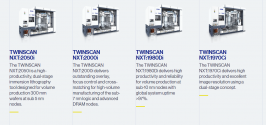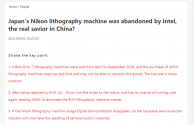You are using an out of date browser. It may not display this or other websites correctly.
You should upgrade or use an alternative browser.
You should upgrade or use an alternative browser.
Chinese semiconductor industry
- Thread starter Hendrik_2000
- Start date
- Status
- Not open for further replies.
The Koreans are being put into a no-win situation.
Once President Trump embarked on the America first policy, which the Biden people inherited and has maintained to a large degree, it meant the world was turning into a free-for-all.
In a free-for-all, such as a cage match in fake WWF wrestling, generally we expect the strong to survive. The midgets wrestlers are the first ones tossed out.
The small states are the most nervous.
I expect them to stay on the American side, at least publicly, until the very end, they will not say much, then at the very last minute switch sides.
You mean at the last minute switch to China's side? I think they don't have much choice but to do as they are told. They are occupied by almost 30000 US military personnel and they have already done things like place THAAD on their territory as well as agreed to relocate large parts of their core industries to US soil for chips and batteries.The Koreans are being put into a no-win situation.
...
...
I expect them to stay on the American side, at least publicly, until the very end, they will not say much, then at the very last minute switch sides.
Can SMIC do 7nm process without EUV at the end of this year? A11 bionic 7nm doesn't use any EUV and only uses in A13 bionic which is 7nm too. So they are 2 version of 7nm EUV and non EUV( DUV)?
A11 : 10nmCan SMIC do 7nm process without EUV at the end of this year? A11 bionic 7nm doesn't use any EUV and only uses in A13 bionic which is 7nm too. So they are 2 version of 7nm EUV and non EUV?
A13 : 7nm
However,
A12 : 7nm (TSMC N7)
A13 : 7nm (TSMC N7P)
From wikichip.org
N7P is an optimized version of TSMC N7 process. to that end, it remains a DUV-based process, keeping the same design rules and is fully IP-compatible with N7. N7P introduces FEOL and MOL optimizations which are said to translate to either 7% performance improvement at iso-power or up to 10% lower power at iso-speed.
So, China doesn't need EUV to produce 7nm. They just need advanced DUV from ASML or from Japan. 7nm is just enough for mobile processor and lower than that is just gimmick.A11 : 10nm
A13 : 7nm
However,
A12 : 7nm (TSMC N7)
A13 : 7nm (TSMC N7P)
From wikichip.org
N7P is an optimized version of TSMC N7 process. to that end, it remains a DUV-based process, keeping the same design rules and is fully IP-compatible with N7. N7P introduces FEOL and MOL optimizations which are said to translate to either 7% performance improvement at iso-power or up to 10% lower power at iso-speed.
I think I saw a chart where it said SMIC would be following on the N+2 process ( 7nm) to an EUV 7nm process.So, China doesn't need EUV to produce 7nm. They just need advanced DUV from ASML or from Japan. 7nm is just enough for mobile processor and lower than that is just gimmick.
But the 7nm of SMIC (N+1) is 35% less powerful than the TSMC 7nm. A gimmick isn't the right way to put it. It's certainly a drawback.
antiterror13
Brigadier
Or Nikon could have partner in China and produce it in China totally without American technology/product, even a screw
Can SMEE 28nm DUV produce 7nm chips???I think I saw a chart where it said SMIC would be following on the N+2 process ( 7nm) to an EUV 7nm process.
But the 7nm of SMIC (N+1) is 35% less powerful than the TSMC 7nm. A gimmick isn't the right way to put it. It's certainly a drawback.
SMEE 28nm equivalent to NXT 1980Di DUV?

- Status
- Not open for further replies.

